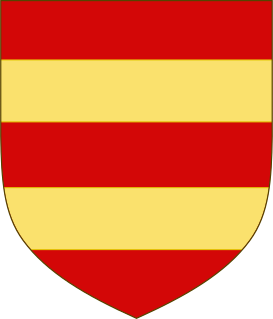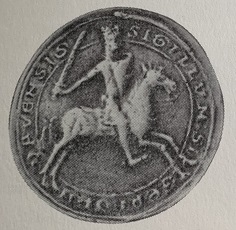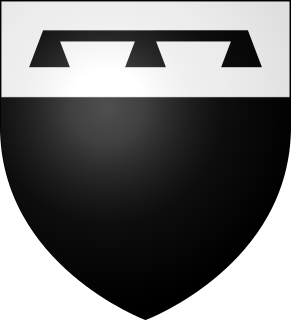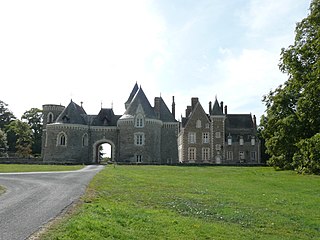Related Research Articles

Melun is a commune in the Seine-et-Marne department in the Île-de-France region, north-central France. It is located in the southeastern suburbs of Paris about 41 kilometres from the centre of Paris. Melun is the prefecture of the Seine-et-Marne, and the seat of an arrondissement. Its inhabitants are called Melunais.

Maine is one of the traditional provinces of France. It corresponds to the former County of Maine, whose capital was also the city of Le Mans. The area, now divided into the departments of Sarthe and Mayenne, counts about 857,000 inhabitants.
Villehardouin was a noble dynasty originating in Villehardouin, a former commune of the Aube department, now part of Val-d'Auzon, France. It is most notable as the ruling house of the Principality of Achaea, a Frankish crusader state in the Peloponnese peninsula of Greece, between 1209 and 1278, when possession passed to the angevin Kings of Naples.

The 91-metre-tall Belfry of Ghent is one of three medieval towers that overlook the old city centre of Ghent, Belgium, the other two belonging to Saint Bavo Cathedral and Saint Nicholas' Church. Its height makes it the tallest belfry in Belgium. The belfry of Ghent, together with its attached buildings, belongs to the set of Belfries of Belgium and France, a UNESCO World Heritage Site.

The House of Baux is a French noble family from the south of France. It was one of the richest and most powerful families of Medieval Provence, known as the 'Race d’Aiglon'. They were independent Lords as castellan of Les Baux and Arles and wielded very considerable authority at local level. They held important fiefs and vast lands, including the principality of Orange.

The Château de Chalmazel, or Château des Talaru is a castle situated in the commune of Chalmazel, in the Loire département of France. It is located in the Haut-Forez, between the towns of Saint-Étienne and Thiers. Its name in medieval times was Saint-Jehan-des-Neiges. The castle dominates the valley of the Lignon and it was built to be an impregnable fortress on the instructions of the Count of Forez.

The House of Harcourt is a Norman family, and named after its seigneurie of Harcourt in Normandy. Its mottos were "Gesta verbis praeveniant", "Gesta verbis praevenient", and "Le bon temps viendra ... de France".

Beauharnais is a French noble family. It is now headed by the Duke of Leuchtenberg, descendant in male line of Eugène de Beauharnais.

The House of Vergy is one of the oldest French noble families, a cadet dynasty related to the 5th century Merovingian Kingdom of Burgundy, attested since the 9th century.
Odo II of Champlitte, was the first son of Odo or Eudes I of Champlitte and a grandson of Hugh, Count of Champagne, although Hugh disowned Odo I.

Zeger III of Ghent was the lord of Heusden, of Bornhem, and of Saint-Jean Steen, and the Châtelain of Ghent. He was the second son of Zeger II, Lord of Ghent and Petronella of Coutrai. His older brother, Arnold, died before 1190, leaving him the heir to the estate of his parents. He took his title of lord of Ghent, Bornhem, and Saint-Jean Steen around 1199. He married Beatrix of Heusden, and through her became Lord of Heusden, a title which was held by his son and progeny.
Walter of Ghent was the second son of Hugues I and Odette de Champagne, daughter of Odo II of Champlitte. Hugues married Lady Avezoete, daughter of Abraham and perhaps of the house of Maelstede. Although his brother inherited the lordship of Heusden and Bornhem, he received the lordship of Sint Jansteen. He took the name Villain, a name synonymous with peasant or farm boy.

Vilain and Vilain XIIII is a Belgian noble family. Their coat of arms is basically "sable, au chef d'argent", a colour scheme that is present from the earliest Vilains in the 15th century, and is also seen in the Vilain XIIII arms, which have the "XIIII" added to it.

The Château de Bourmont is a converted castle in the commune of Freigné in the Lot département of France.
The title Count of Champlitte was created by letters patent on September 5, 1574 by Philip II, King of Spain, for Francois de Vergy, son of Guillaume de Vergy the Seigneur de Champlitte.
Guy II the Red de Montlhéry, son of Guy I, Seigneur de Montlhéry, and Hodierne de Gometz-la-Ferté. He held the titles of Count of Rochefort-en-Yvelines and Châtelain of Châteaufort and of Gometz, and was Seneschal of France under Philip I the Amorous, 1104-1106.

The house of Hénin is a family of the Belgian high nobility, one of its branches was titled Prince of Chimay. Alliances were made with important Spanish noble families such as house of Borja and the house of Velasco.
Victor Louis Marie Gaillard (1825—1856) was a Belgian lawyer, numismatist, historian and archivist.
Beatrix van Heusden was a Flemish viscountess. She was the daughter of Hughes of Heusden, son of Anselm III, Lord of Heusden.
References
- ↑ Auguste Havenith, Recherches historiques sur le château et la seigneurie de Heusden, autrement dite vicomté de Gand (De Backer, 1900), p. 141-144
- ↑ Auguste Havenith, Recherches historiques sur le château et la seigneurie de Heusden, autrement dite vicomté de Gand (De Backer, 1900), p. 147
- ↑ Auguste Havenith, Recherches historiques sur le château et la seigneurie de Heusden, autrement dite vicomté de Gand (De Backer, 1900), p. 148-149
- ↑ F. Blockmans, Peilingen nopens de bezittende klasse te Gent omstreeks 1300 (II). Revue belge de philologie et d'histoire (1937) V 16. Issue 16-3-4 pp. 632-665